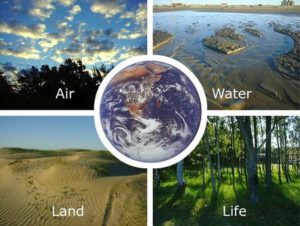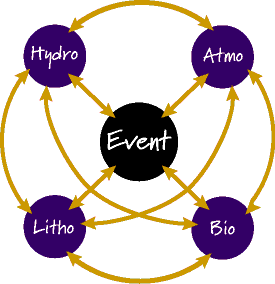Earth Systems
Callan Bentley, Karen Layou, Russ Kohrs, Shelley Jaye, Matt Affolter, and Brian Ricketts and Charlene Estrada
Throughout its entire 4.54 Ga history, every event in the history of our planet happened because something forced it to happen. As we’ve reviewed in the previous section, an asteroid caused the extinction of the dinosaurs at the end of the Cretaceous period. Extinctions led to new evolutionary pathways for the origination of species. Plate tectonics caused continents to move around. In each of these realities, we might be tempted to simply describe them as they have been here, in a linear fashion. A caused B. We could leave it at that. However, is it that simple?
Within the Earth system, there are subsystems. These subsystems encompass the space environment (exosphere), gaseous environment (atmosphere), liquid environment (hydrosphere), solid environment (lithosphere and geosphere, hereafter lithosphere), and living environment (biosphere). In some cases, the icy environment (cryosphere) is broken away from the hydrosphere and the anthroposphere (human environment) from the biosphere for emphasis.
Energy, coming from the Sun on the one hand and the Earth’s interior on the other, powers these systems. As energy flows through these systems, so do nutrients and elements through biogeochemical cycles. Examples of these include the carbon and nitrogen cycles.

Earth systems science seeks to understand the interconnectedness of our planet’s air, water, land, and life (M. Ruzek 1999).
The Earth system is made up of four fundamental subsystems, or spheres. The atmosphere, hydrosphere, biosphere, and lithosphere/geosphere. In the diagram below and to the left, these are abbreviated. In a moment, we will explore an expanded view of these spheres that includes six of them.

Graphic: Wheeling Jesuit University/NASA Classrooms of the Future; reproduced with permission.
Events affect the Earth system as a whole, though they usually begin within a particular sphere. Let us explore a volcanic eruption as an example. When a volcanic eruption event occurs, what happens?
- Ash and rock are blasted into the atmosphere;
- Gases are emitted into the atmosphere;
- Lava may run downslope;
- Pyroclastic flows, superheated ash, may rush downslope at great velocity;
- Lahars, or mudflows, may result from the rapid melting of snow and ice, bringing large amounts of debris downslope;
- Flora and fauna near the volcano may be killed.
There are other effects associated with volcanic eruptions beyond these. If you were to place the eruption in the very center of this diagram and write some of these interactions along the golden arrows toward a sphere, where would you place them? These are direct effects on each sphere from the event.
These direct effects are not the end of the story. You can see that there are also arrows connecting each sphere. What are some of the indirect interactions (forcings) that result from the eruption? How is the biosphere affected, for example, by how the eruption directly affects the lithosphere (geosphere)? Ultimately, understanding the interconnectedness of the Earth system is critical for gaining a holistic view of how our planet is affected by individual events. In the history of our planet, there has been no shortage of such events!
The table below shows some of the relationships between these events that cause a relationship to form between the different spheres, called forcing events. They are called forcing events because they cause a shift in energy flow from one system to another.
Consider how the different systems are connected with these event scenarios below:

